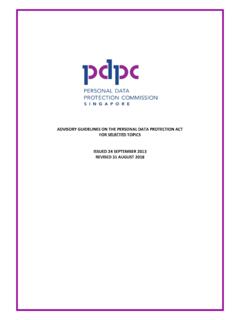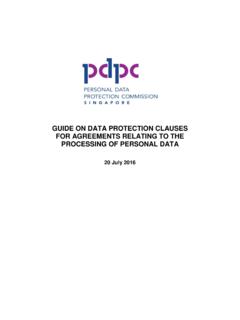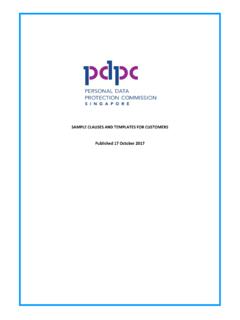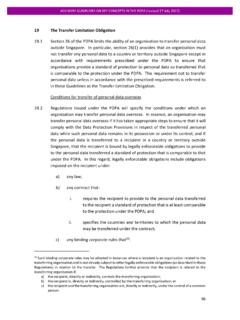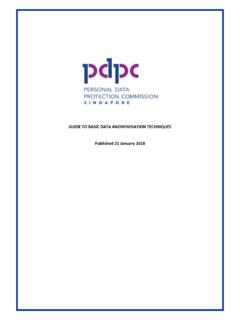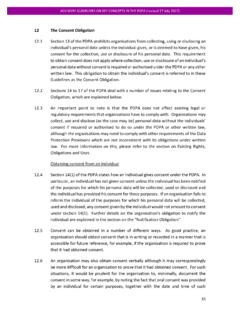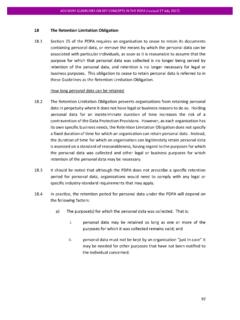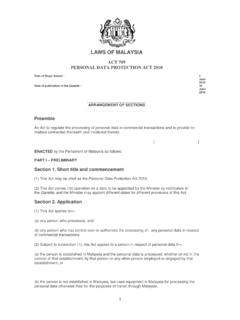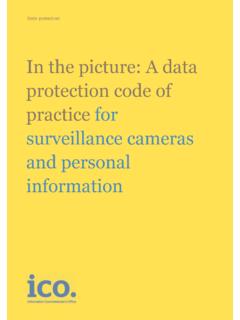Transcription of ADVISORY GUIDELINES ON THE PERSONAL DATA …
1 ADVISORY GUIDELINES ON THE PERSONAL data protection ACT FOR NRIC AND OTHER NATIONAL IDENTIFICATION NUMBERS Issued 31 August 2018 1 ADVISORY GUIDELINES ON THE PERSONAL data protection ACT FOR NRIC AND OTHER NATIONAL IDENTIFICATION NUMBERS (issued 31 August 2018) TABLE OF CONTENTS PART I: INTRODUCTION .. 2 1 Background .. 2 2 Overview of the data protection Provisions .. 3 PART II: APPLICATION OF data protection PROVISIONS .. 5 3 Collection, use or disclosure of NRIC numbers (or copies of NRIC) .. 5 4 Retention of Physical NRIC.
2 9 5 Alternatives to NRIC .. 10 PART III: IMPLEMENTATION .. 14 6 Implementation timeframe .. 14 2 ADVISORY GUIDELINES ON THE PERSONAL data protection ACT FOR NRIC AND OTHER NATIONAL IDENTIFICATION NUMBERS (issued 31 August 2018) PART I: INTRODUCTION 1 Background These GUIDELINES should be read in conjunction with the document titled Introduction to the GUIDELINES "1. The Singapore National Registration Identification Card ( NRIC ) number is a unique identifier assigned by the Singapore Government to Singapore citizens and permanent residents of registrable age under the National Registration Act.
3 It is often used for transactions with the Government as well as in commercial transactions. The NRIC number of an individual is considered PERSONAL data as the individual can be identified from the unique sequence of numbers and letters. As the NRIC number is a permanent and irreplaceable identifier which can potentially be used to unlock large amounts of information relating to the individual, the collection, use and disclosure of an individual s NRIC number is of special concern. Indiscriminate or negligent handling of NRIC numbers increases the risk of unintended disclosure with the result that NRIC numbers may be obtained and used for illegal activities such as identity theft and fraud.
4 The retention of an individual s physical NRIC is also of concern. The physical NRIC not only contains the individual s NRIC number, but also other PERSONAL data , such as the individual s full name, photograph, thumbprint and residential address. These GUIDELINES clarify how the PERSONAL data protection Act 2012 ( PDPA ) applies to organisations collection, use and disclosure of NRIC numbers (or copies of NRIC), and retention of physical NRICs2 by organisations. Under the updated GUIDELINES , organisations are generally not allowed to collect, use or disclose NRIC numbers (or copies of NRIC).
5 The treatment for NRIC numbers also applies to Birth Certificate numbers, Foreign Identification Numbers ( FIN ) and Work Permit numbers, collectively referred to in these GUIDELINES as other national identification numbers . While passport numbers are periodically replaced, they too are important identification numbers that can serve the same purposes as the NRIC, FIN, Work Permit and Birth Certification numbers. Therefore, organisations should accord passports similar treatment as that for NRICs, refrain from collecting passport numbers.
6 If there is a need to collect passport numbers, organisations should limit their collection to partial passport numbers and ensure an appropriate level of security to protect the passport numbers collected. 1 Available at 2 To be clear, NRIC refers to both pink and blue NRIC. 3 ADVISORY GUIDELINES ON THE PERSONAL data protection ACT FOR NRIC AND OTHER NATIONAL IDENTIFICATION NUMBERS (issued 31 August 2018) The treatment for retention of physical NRIC applies to other identification documents containing the NRIC numbers or other national identification numbers ( driver s licence, passport and work pass).
7 These GUIDELINES do not apply to the collection, use and disclosure of NRIC numbers (or copies of NRIC), and the retention of physical NRICs by a public agency or an organisation that is acting on behalf of a public agency. Public agencies in Singapore (including Government Ministries, Statutory Boards and Organs of State) are excluded from the data protection Provisions of the PDPA3. 2 Overview of the data protection Provisions Organisations are generally not allowed to collect, use or disclose NRIC numbers (or copies of NRIC).
8 Where organisations are permitted to collect NRIC numbers of individuals, they will nevertheless have to comply with the data protection Provisions under the PDPA. The data protection Provisions of the PDPA contain a number of obligations which are elaborated in the PDPC s ADVISORY GUIDELINES on Key Concepts in the PDPA ( Key Concepts GUIDELINES ). Among other obligations, the PDPA requires organisations to develop, implement and regularly review their policies and practices that are necessary to meet their obligations under the PDPA.
9 The Consent4, Notification5 and Purpose Limitation6 obligations require organisations to notify an individual of the purposes for the collection, use and disclosure of his or her PERSONAL data , including NRIC number, and obtain his or her consent, unless it is required under any law or an exception7 under the PDPA applies. In situations where an individual voluntarily provides his or her PERSONAL data to an organisation for a purpose and it is reasonable8 that he or she would voluntarily provide the data , the individual is deemed to consent to the collection, use or disclosure of the PERSONAL data .
10 3 The data protection Provisions are found in Parts III to VI of the PDPA. Section 4(1)(c) of the PDPA provides that Parts III to VI shall not impose any obligation on any public agency or organisation in the course of acting on behalf of a public agency in relation to the collection, use or disclosure of the PERSONAL data . 4 Sections 13 to 17 of the PDPA. 5 Section 20 of the PDPA. 6 Section 18 of the PDPA. 7 Please refer to the Second, Third and Fourth Schedules under the PDPA for exceptions which may apply.
